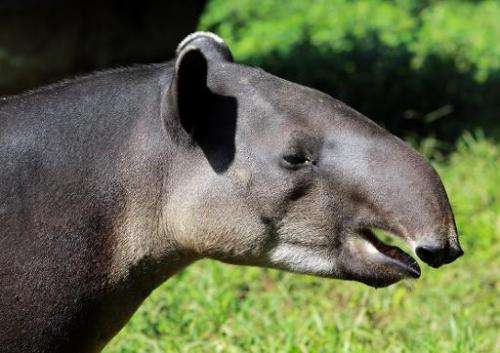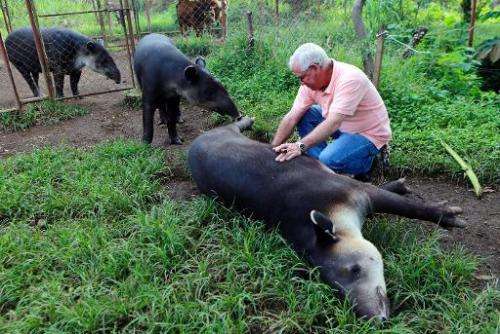Nicaragua gears up to aid threatened tapirs

Nicaragua is pulling out the stops to try to aid threatened tapirs, an endangered mammal sometimes mistaken for anteaters or tiny hippos.
Experts in Nicaragua say the tapir's long gestation period, poaching and loss of habitat caused by logging have led to dwindling numbers of the distinct-looking animal.
"The tapir is the most endangered animal right now in Nicaragua, and in the world, because its gestation period is so long—they are pregnant for 400 days—so they are dying out," Eduardo Sacasa, a veterinarian in charge of Nicaragua's National Zoo tapir project, told AFP.
At home in forests of Central and South America, and Southeast Asia, tapirs have a fleshy prehensile nose able to help them grab leaves and breathe while swimming.
Aside from their long pregnancies, they usually have just one offspring per birth. They can grow as large as 300 kilos (660 pounds), live up to 18 years and have hooves similar to horses or rhinos.
The animals are nicknamed "the gardener of the forest" since they play a huge role in dispersing seeds.
Looking on at a pair of zoo-bred tapirs that will soon be released and tracked, Sacasa said of two-year-olds Maya and Carburito: "We'll see how widely they range, how they adapt... if they can survive. Or not."

In a few months, the pair will be flown on an army helicopter to Kahka Creek, a 650-hectare (1,600-acre) nature reserve on Nicaragua's Caribbean coast.
It is a remote area where Sacasa said "many small farmers are willing to cooperate" with what the zoo is trying to do: "to save Nicaragua's tapirs." There are thought to be about 500 left in this country, down from 2,000 a few years back.
Hunted for food
The four different species of tapir around the world are all regarded as either endangered or threatened.
The Nicaraguan project also has been supported by American specialist Christopher Jordan from Michigan State University, the environment ministry and a local NGO.
In the nature reserve, there are 65 cameras that will help scientists keep an eye on how tapirs and other animals are faring, Sacasa explained.
Before it can release Maya and Carburito, the zoo is rushing to fence in the sprawling reserve. It is hoping to raise the $10,000 or so it needs with a social media campaign.
Tapirs are threatened in Nicaragua, Honduras and Costa Rica, largely because they continue to be hunted for food by people, said Enrique Rimbaud, who leads the animal protection group Amarte.
He said the local regional government where the reserve is allows indigenous people to hunt up to four annually to eat, another factor endangering the animal's population.
© 2013 AFP



















